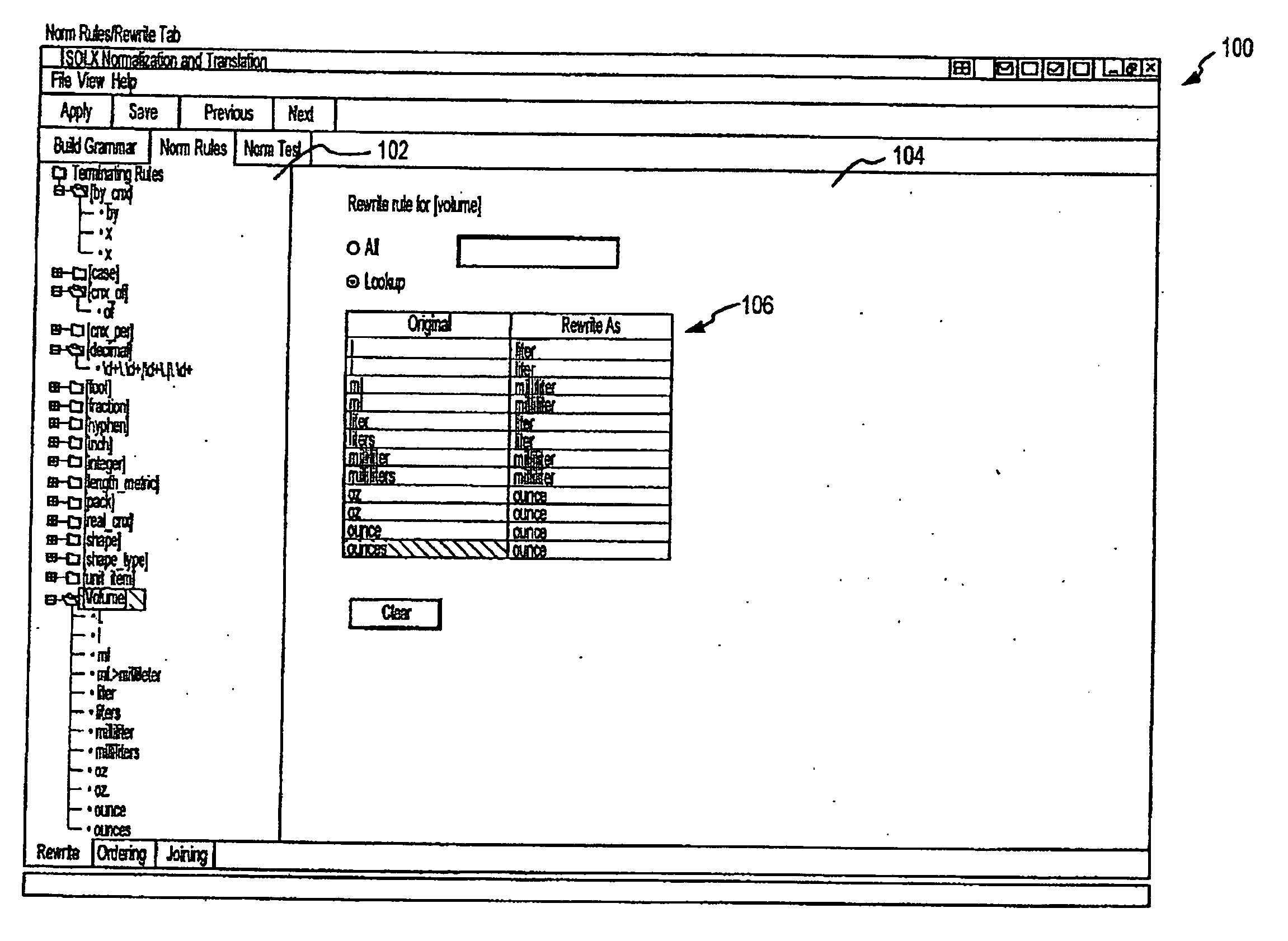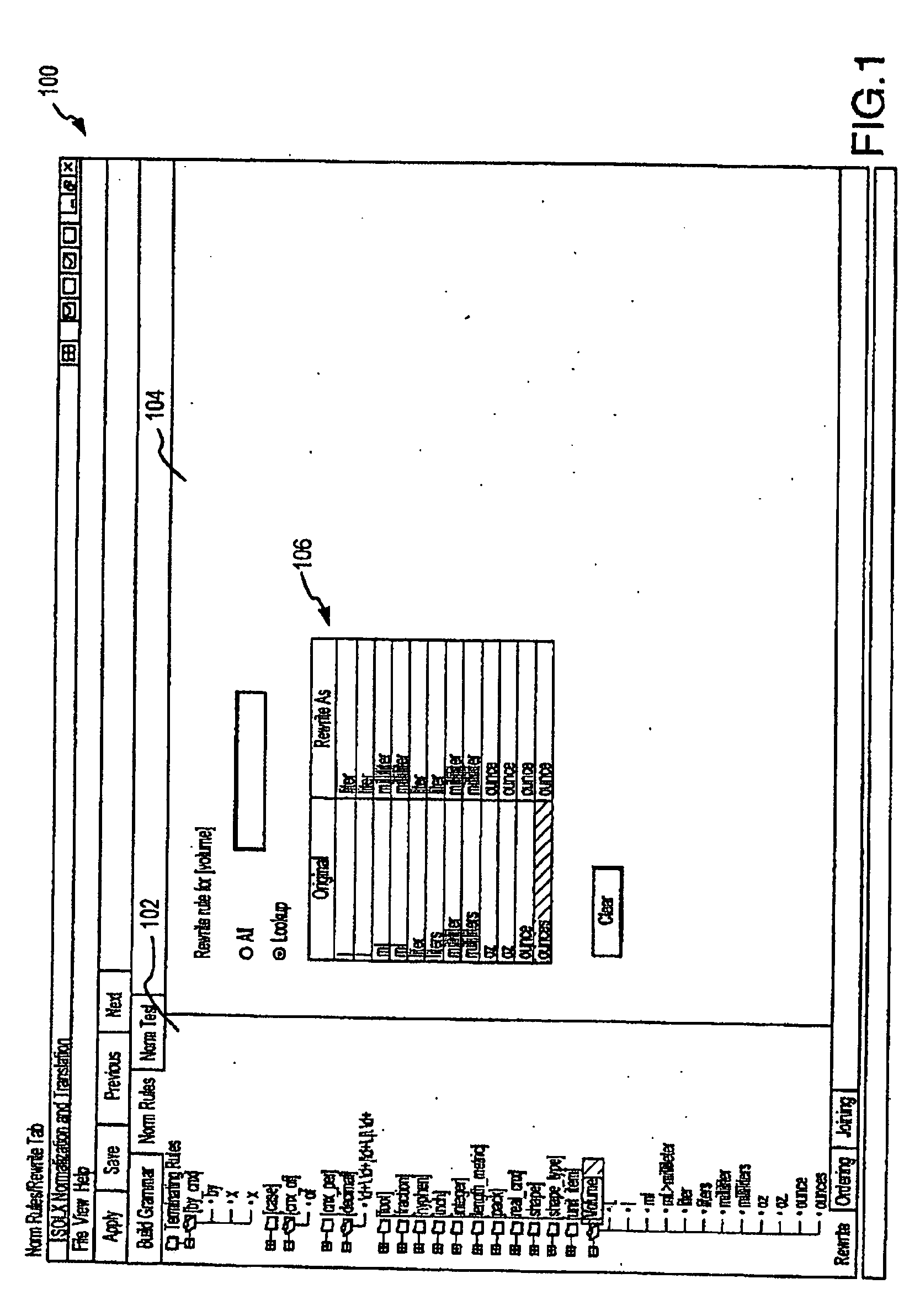[0007] It has been recognized that there is a need for search logic that provides the ease-of-use of term searching with the comprehensiveness of category searching. Such search logic would be useful for catalog searching or other
data system searching applications. In accordance with the present invention, a
knowledge base is constructed by which item descriptor terms and / or potential
search terms are associated with
contextual information by which the search logic can associate such a term including a specific, colloquial or otherwise idiosyncratic term, with a
subject matter context, so as to enable a more complete search to be performed and increase the likelihood of yielding useful results.
[0009] The
classification structure preferably has a hierarchical form defined by classes, each of which includes one or more sub-classes, and so on. The utility further involves associating each of the potential
search terms with the
classification structure such that the term is assigned to at least one sub-class and a parent class. For example, such associations may be reflected in an
XML tag structure or by any other
system for reflecting such
metadata structure. In this manner, search terms are provided with a
subject matter context for facilitating searching. Thus, in the Daytimer example noted above, a search query including the term Daytimer may be interpreted so as to provide search results related more generally to appointment books. For example, such a search may be implemented iteratively such that the search system first seeks results matching “Daytimer” and, if no responsive information is available, proceeds to the next rung on the classification system, for example, “Appointment Books.” Such iterations may be repeated until results are obtained or until a predetermined number iterations are completed, at which point the system may return an
error message such as “no results found.”
[0010] In accordance with another aspect of the present invention, similar context information may be provided to terms associated with the data to be searched or
source data. The utility generally involves providing a
list of
source data terms defining a
subject matter area of interest and establishing a
classification structure for the
source data terms. Again, the classification structure preferably has a hierarchical form including classes each of which includes one or more sub-classes, and so on. Each of the source terms is associated with the classification structure such that the source term is assigned to at least one of the sub-classes and an associated parent class. In this manner, context is provided in connection with source data to facilitate searching. Thus, for example, a search query including the term “Appointment Book” may retrieve source data pertaining to Daytimer products, even though those products' descriptors may not include the term “Appointment Book.”
[0013] In accordance with a still further aspect of the present invention, a
data search is facilitated based on a
standardization of terms utilized to execute the search. It has been recognized that term searches are complicated by the fact that searchers may enter terms that are misspelled, colloquial, or otherwise idiosyncratic. Similarly, source data may include jargon, abbreviations or other matter that complicates term matching. Accordingly, term searches can be facilitated by standardizing one or both of the search terms and source terms. For example, a user searching for Post-it notes may enter a colloquial term such as “sticky tabs.” This term may be rewritten by a utility according to the present invention, as, for example, “
adhesive notepad” or some other selected standard term. In addition, the term may be associated with a classification as discussed above. Similarly, a source collection, such as a catalog, may include a highly stylized entry for a Post-it note product such as “3-Pk, 3×3 PI notes (pop-up)—Asst'd.” Such an entry may be rewritten to include standard terminology and
syntax. In relevant part, the term “PI notes” may be rewritten as “Post-it notes” and may be associated with the classification “
adhesive notepad.” Thus, a first order classification of the source term matches the standardized search term, thereby facilitating retrieval of
relevant information. As this example illustrates, such matching is not limited to matching of terms rewritten in standardized form or matching of classifications, but may involve matching a rewritten search term to a classification or vice-versa.
[0015] As a further example, such functionality may facilitate searching of multiple legacy databases, e.g., by an inside or outside party or for advanced
database merging functionality. Oftentimes, an entity may have information related to a particular product, company or other subject matter in multiple legacy databases, e.g., a product
database and an accounting database. These databases may employ different conventions, or no taut conventions, regarding linguistics and
syntax for identifying common data items. This complicates searching using conventional database search tools and commands, and can result in incomplete search results. In accordance with the present invention, a defined
knowledge base can be used to relate a search term to corresponding information of multiple legacy systems, e.g., so that a substantially
free form search query can retrieve
relevant information from the multiple
legacy system despite differing forms of that information in those legacy environments.
 Login to View More
Login to View More  Login to View More
Login to View More 


